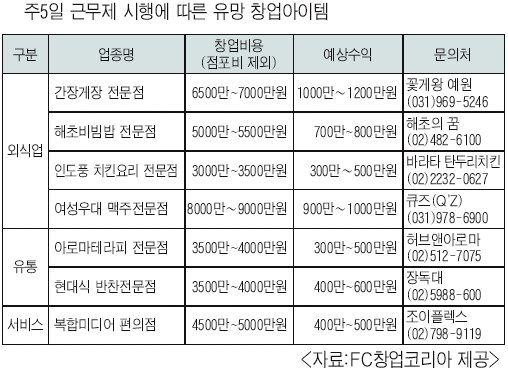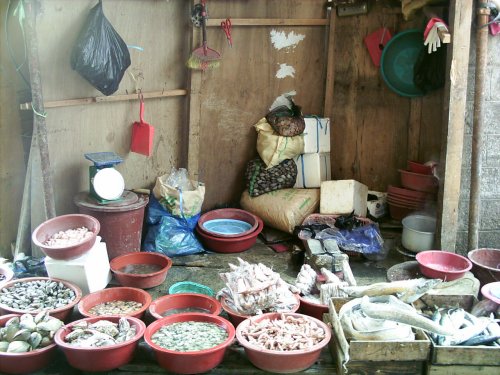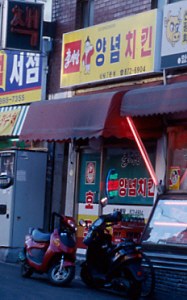Hankyoreh has a couple of pieces of modern and traditional Korea, so to speak.
(1) The oldest daughter of the head of the Presidential secretariat (청와대 비서실장) Mun Hui-sang got married in Lotte Hotel in February 1st. No invitations had been sent, "to avoid unnecessary misunderstanding", and all congratulation money (ch'ugûigûm 축의금) and flower wreaths (hwahwan 화환) were refused. (It was most likely Mun who did the refusing and not the couple, since the literal expression is that it was Mun who had his daughter's wedding, 문희상 청와대 비서실장이 1일 낮 시내소공동 롯데호텔에서 큰 딸 수현씨(32)의 조촐한 결혼식을 가졌다. Mun even discouraged the government dignitaries to participate, saying "it's ok if you don't come" to those who had heard that there will be a wedding. Only president Roh's and former president Kim Dae-jung's wreaths were accepted, others were refused (사절했다, 돌려보냈다). So only few dignitaries were present, and the wedding was held mainly in the presence of families and friends. The bride is 32 and the groom 38 (!), a noch'onggak indeed, but he is a SNU politics dept graduate, he has passed the law exam (sapôp kosi) and has finished his law training.
Several years ago, during Kim Dae-jung's presidency, there was the wedding of the offspring of Kwon No-gap (or Kwon Roh-gap, I'm not sure), who is a long-time KDJ confidant and who was in an important party position at the time (after serving some time for the Hanbo scandal). He also didn't send any wedding invitations, but according to different police estimations, 3000 to 5000 people turned up to give their congratulations. The closer to the president the person is, the closer events like this will be watched, and more careful those responsible need to be. The fact that extra carefulness needs to be excerted and weddings intentionally downplayed tells of the continuous importance of the institution.
(2) People in a village in Southern Kyôngsang (Gyeongsang) have given a "Filial Daughter-in-law price" to a woman, who has not lost her smile and friendliness despite taking care of an ailing mother-in-law and working full-time in the township office (myônsamuso). (Hyobu 孝婦 = filial, dutiful daughter-in-law.)송씨는 특히 시어머니가 중풍으로 병상에 눕자 식사수발과 대소변을 받는 병수발을 마다않고 힘겨운 집안을 척척하면서도 늘 밝고 성실하게 면사무소 공무원으로일해 마을주민들로부터 칭찬이 자자하다.
"People around help me a lot, so this is not hard at all", said Mrs Song in the village hall in the awarding ceremony. "I'm sorry and ashamed to receive such a big price, because I'm only doing what a civil cervant and a daughter-in-law is supposed to do." Giving awards like this is what makes the blood boil in certain circles, who would call for a more equal burden of homework between spouses and for less practice of filiality through the daughter-in-law. And it shouldn't be in Hankyoreh's editorial policy to advocate filial daughters-in-law who don't spare toil in taking care of their mothers-in-law, as it sounds so patriarchal and conservative. But perhaps it's fitting for the "productive welfare" policy (or what was it called) of the present government. (The article was from Yonhap.)
Categories at del.icio.us/hunjang: family/kin • Koreanculture • Koreanpolitics |
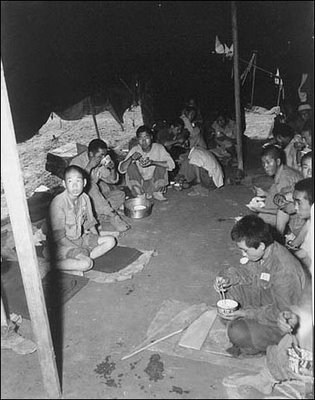 1950. 8. 18. 포로수용소 천막 안에서 밥을 먹고 있다 (POW camp)
1950. 8. 18. 포로수용소 천막 안에서 밥을 먹고 있다 (POW camp)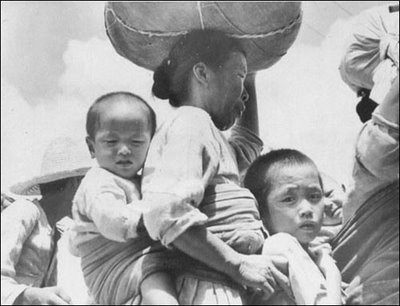
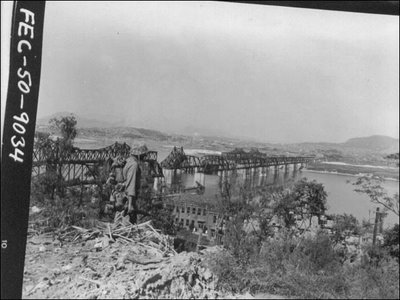



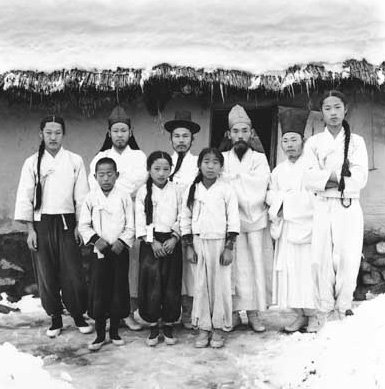 Here's a picture of a hunjang (third from right in back row) with his students in Kangwon-do in the late 1950s, taken from professor Lee Mun-woong's
Here's a picture of a hunjang (third from right in back row) with his students in Kangwon-do in the late 1950s, taken from professor Lee Mun-woong's 





 Here's also a bit older "ordinary people" reference from Hankyoreh21 weekly;
Here's also a bit older "ordinary people" reference from Hankyoreh21 weekly; 
 Found a site with a lots of downloadable (haven't really checked out yet) music and concert videos at http://me2u.co.kr.One gem at the site is a Kim Kwang-seok concert from 1995 one year before his suicide. It can be found from the Music Video II link on the left, and then clicking 김광석 수퍼콘서트 (Kim Kwang-seok superconcert) in the list. Below is the set list.
Found a site with a lots of downloadable (haven't really checked out yet) music and concert videos at http://me2u.co.kr.One gem at the site is a Kim Kwang-seok concert from 1995 one year before his suicide. It can be found from the Music Video II link on the left, and then clicking 김광석 수퍼콘서트 (Kim Kwang-seok superconcert) in the list. Below is the set list.







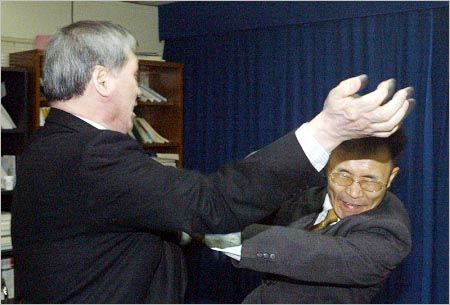
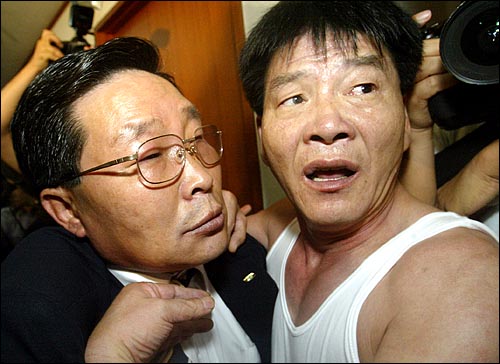 The undergarment that is colloquially called "wife beater" in the US is called "party fraction beater" in South Korea. This is Minjudang fractions discussing politics last autumn.
The undergarment that is colloquially called "wife beater" in the US is called "party fraction beater" in South Korea. This is Minjudang fractions discussing politics last autumn.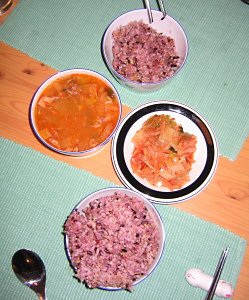
 Earlier I had a
Earlier I had a 
 happy to see a European; he had been given such a good treatment as a captain of a ship in Europe, compared to the low status of his occupation in Korea. "Sônjangûn sangnomida" (sea captain is a low person), is what they think in Korea according to him. [Here's the almost compulsory Korean social structure part of this post.] He wanted to treat me well, as if repaying the esteem he had been given in Europe and elsewhere, so there was no end to the flow of meat and soju to our table. Next time I went back to the place I was told we had emptied 7 bottles. I was also told that the retired sea captain shouldn't have been drinking in the first place because of his heart condition, and that he had been really ill after treating me and himself. I never saw him again. (Let's say I was pleased that nothing more serious was supposed to have happened to him.)
happy to see a European; he had been given such a good treatment as a captain of a ship in Europe, compared to the low status of his occupation in Korea. "Sônjangûn sangnomida" (sea captain is a low person), is what they think in Korea according to him. [Here's the almost compulsory Korean social structure part of this post.] He wanted to treat me well, as if repaying the esteem he had been given in Europe and elsewhere, so there was no end to the flow of meat and soju to our table. Next time I went back to the place I was told we had emptied 7 bottles. I was also told that the retired sea captain shouldn't have been drinking in the first place because of his heart condition, and that he had been really ill after treating me and himself. I never saw him again. (Let's say I was pleased that nothing more serious was supposed to have happened to him.)

 청와대
청와대  사회지도층의 화환 풍습이 이제 바뀌고 있음으로 앞으로 꽃집과 선거사무실이 외부인들에게 구별하기 더 쉽게 된다고 예상된다. 선거철 때마다 선거사무실에 들어가고 예쁜 꽃 좀 포장해 달라고 창피를 당할 가능성이 줄일 전망이다. "지난 지방선거 때 어느 후보의 선거사무실에서 찍은 사진을 어머님께 보여드렸더니 꽃집인 줄 아시더라"고 한 외국인도 했다고 한다. 또 한편으로 올 4월의 국회선거 후보들은 화환, 꽃배달이 더 이상 들어오지 않으면 사무실을 어찌 구미겠는가 하는 고민을 하고 있다고 전해진다. 그 결과로 화환, 난(蘭) 배달이 줄이고 있는 가운데 선거사무실의 인테리어 디자인은 새로운 사업아이템으로 떠오를 것으로 보인다.
사회지도층의 화환 풍습이 이제 바뀌고 있음으로 앞으로 꽃집과 선거사무실이 외부인들에게 구별하기 더 쉽게 된다고 예상된다. 선거철 때마다 선거사무실에 들어가고 예쁜 꽃 좀 포장해 달라고 창피를 당할 가능성이 줄일 전망이다. "지난 지방선거 때 어느 후보의 선거사무실에서 찍은 사진을 어머님께 보여드렸더니 꽃집인 줄 아시더라"고 한 외국인도 했다고 한다. 또 한편으로 올 4월의 국회선거 후보들은 화환, 꽃배달이 더 이상 들어오지 않으면 사무실을 어찌 구미겠는가 하는 고민을 하고 있다고 전해진다. 그 결과로 화환, 난(蘭) 배달이 줄이고 있는 가운데 선거사무실의 인테리어 디자인은 새로운 사업아이템으로 떠오를 것으로 보인다. 